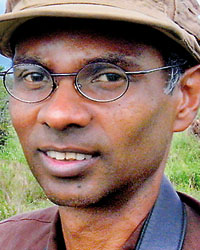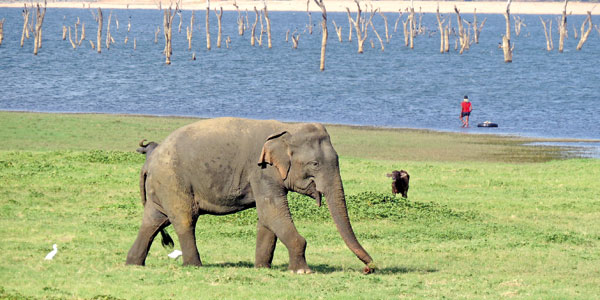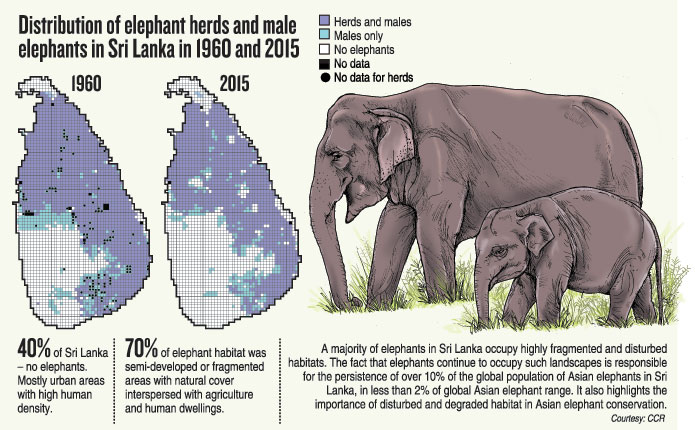News
Humans and elephants are living together
- Pioneering study finds 42% of Sri Lanka being the habitat of both
- ‘Co-existence’ model the only way forward
The cat, nay the elephant, is out of the bag!
A majority of wild elephants live in areas where men, women and children live and have done so for a long time.
This is fact and not fiction, dispelling long-held contrary expert views, the Sunday Times learns, while also reinforcing the conclusion that the only viable option or win-win situation is a human-elephant ‘co-existence’ model.
These facts have been established through the first-ever countrywide evidence-based study in Sri Lanka which has also yielded the first-ever Asian elephant distribution map in the world.
The study titled ‘First country-wide distribution survey of the endangered Asian elephant: Towards better elephant conservation and management in Sri Lanka’ has been published in the prestigious peer-reviewed ‘Oryx – The International Journal of Conservation’ on February 6. It is freely accessible on the web.

Cow elephant and babies at Minneriya. (Pic courtesy of CCR)
The study team, from the Centre for Conservation and Research (CCR) headed by Dr. Prithiviraj Fernando, divided the country into 2,714 grids, of 25 square kms each. They then fanned out across the country on motorcycles and four-wheel drive vehicles, visiting each and every 25 sq km grid and asking questions from three long-term residents in each grid to get right the overall mapping of where wild elephants live. The survey was carried out from 2011 to 2015.
To get the ground situation, at each interview the researchers asked the people a crucial question: Do you have wild elephants in your neighbourhood within 1 to 2 kms of your home?
Of course, the questioning of the people was not carried out blindly and Dr. Fernando cites cities like Colombo or Kandy where such a query would be ridiculous. Here, what the researchers did ask people around 60 years of age or older was whether they have known or heard of wild elephants being in these areas in living memory or earlier. This had helped them to gather the history of the area with regard to wild elephants for about 60 years.

Dr. Prithiviraj Fernando
The answers, not hearsay, have led to important revelations:
Wild elephants live in a large area — 60% (more than half) of Sri Lanka and are not at all limited to Protected Areas (PAs) alone.
People are resident in 82% of Sri Lanka.
The 18% of Sri Lanka without resident people consists of Wildlife and Forest Department PAs and most of them have elephants.
When taking the 60% of Sri Lanka where wild elephants roam, only 30% of it is in PAs, with the balance 70% being outside the PAs, in areas where humans also live.
“This is a lot more than what we believed or expert opinion touted with a lot of conviction,” stresses Dr. Fernando about the survey findings.
The study had found that earlier, about 60 years ago, there had been wild elephants in 75% of Sri Lanka and that they had lost about 16% of their range, while re-expanding into about 1.4% of their former range during that period. So the net change of ranging ground for the elephants has been a loss of about 15%.
“People either said that there were wild elephants in their areas earlier but not now, while others indicated that ‘elephants had been there, then vanished but came back again later’,” he explains.

A wild elephant and a man in close proximity at Kaudulla. (Pic courtesy of CCR)
Such a range loss, it is learnt, indicates a declining elephant population, as opposed to the popular belief that their numbers are increasing. This is because the number of animals of a species that can survive is directly related to the extent of range they occupy.
In the near future, Dr. Fernando and his team are hoping to set up a database with mapping of the elephant range for the public to access on the web.
“We will need a few months to do this,” he adds.
| Futility of elephant drives but development can be based on distribution map Many are the lessons that Sri Lanka, be it the government, businesses, investors, conservation agencies, environmental groups, non-governmental organisations or people, can learn from this study. Policy can be shaped based on science, to protect the much-revered elephant and effectively mitigate the human-elephant conflict. The lessons are: It is impossible and futile to conduct exorbitantly-costing elephant drives and translocations as the country has been doing in the past 60-70 years in attempts to ‘confine and restrict’ wild elephants to Protected Areas (PAs). There are more wild elephants outside the PAs than inside. If Sri Lanka persists in attempts to continue drives and translocations for the ‘attempted’ mitigation of the human-elephant conflict (HEC), the 70% of wild elephants pushed so into PAs, as well as the elephants inside the PAs will, for sure, face a death sentence through starvation, says Dr. Prithiviraj Fernando. He asks how wild elephants can be taken from 70% of their range and be squeezed into 30% of their range in the PAs, especially when the PAs already have the number of elephants they can carry. He waves a red flag over the fact that those elephants which resist such drives and remain outside the PAs become very aggressive towards people, leading to the escalation of the HEC. The distribution of the wild elephant in Sri Lanka can be the ‘guide’ for government or corporates who wish to invest in projects in the country. Elaborating how this ‘Wild Elephant Guide’ could be used, Dr. Fernando says that potential projects can be assessed based on it, at the project planning stage – do the project proponents wish to launch a project which may attract elephants like banana or maize (corn) cultivations in an area which is densely-populated by elephants? This would be “asking for trouble”. Thus, when national development priorities are being set, the ‘Wild Elephant Guide’ will come in handy at the very outset of project planning. If a project is to be in areas where the wild elephants roam and will cause HEC, but has to be done because of national importance, mitigatory measures would have to be included in the project plan, incorporating sustainable mechanisms and funding for their implementation in perpetuity. Otherwise, such projects should be blacklisted as “irresponsible” by regulatory authorities such as the Central Environmental Authority (CEA). | |
| Crucial to ensure contiguity The wild elephant distribution map is also an invaluable tool in the conservation of this ‘globally endangered’ species, says Dr. Prithiviraj Fernando. His team’s study has found that the areas inhabited by wild elephants can be grouped into two – areas where both herds (cow and baby elephants) and adult males live and areas where only adult males live. In areas where there has been a high-level of human-elephant conflict (HEC), there is a gradual decline in the number of herds, leading to only adult males roaming there. If development and an increase in the HEC continue in such areas, elephants will ultimately become extinct locally (in those areas). Dr. Fernando points out that even though the global Asian elephant range has faced severe decline and fragmentation with isolation of populations, their study found that the Sri Lankan population was still contiguous, except for two small groups that are isolated in the Wet Zone in the forests of Adam’s Peak and Sinharaja. Only adult males being in some areas indicated that gaps are occurring in contiguity. These are the critical areas which need to be preserved, with elephant corridors being created to maintain contiguity for posterity. |


